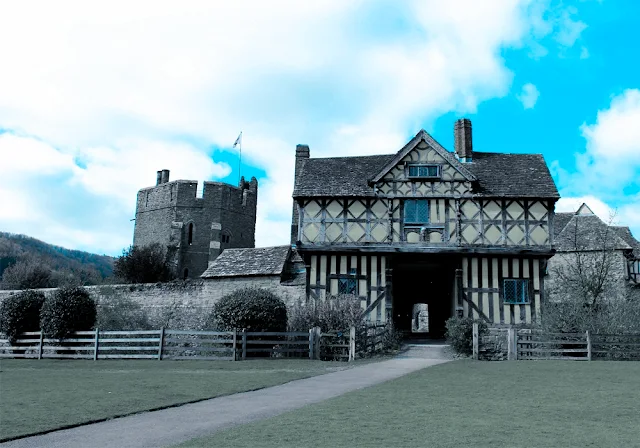Stokesay Castle – A Medieval Gem in Shropshire, England
Tucked away in the picturesque countryside of Shropshire, England, Stokesay Castle is one of the best-preserved fortified manor houses in the country. Built in the late 13th century by Laurence of Ludlow, a wealthy wool merchant, Stokesay Castle offers a fascinating glimpse into medieval life. Despite its name, it is more of a grand manor house than a military fortress, blending elements of domestic comfort with medieval architecture. The castle's half-timbered gatehouse, soaring tower, and charming great hall remain largely untouched by the passage of time, making it a rare and exquisite example of medieval architecture.
Stokesay Castle stands as a peaceful testament to a bygone era, a contrast to the violent conflicts that often marked the construction of castles during the medieval period. Its tranquil setting amidst rolling hills, combined with its well-preserved condition, offers visitors an enchanting journey back to the Middle Ages, where they can explore the castle’s history and discover its unique blend of defensive and domestic architecture.
Detailed Guide to Stokesay Castle
The Great Hall: The centerpiece of Stokesay Castle is its magnificent Great Hall, which remains virtually unchanged since the 13th century. This grand room, with its soaring timber roof, large windows, and open hearth, was the heart of life at Stokesay, where the lord and his family would dine and entertain guests. The hall's immense size and medieval features offer a rare glimpse into the domestic life of a wealthy wool merchant of the time. Visitors can still see the original 13th-century timberwork, one of the finest examples of medieval craftsmanship in England.
The Solar and North Tower: Adjacent to the Great Hall is the solar, a private chamber used by the lord and his family. This room, with its cozy fireplace and views of the surrounding countryside, provided a retreat from the public life of the hall. The North Tower, which rises above the castle’s grounds, offers panoramic views of the Shropshire landscape. Originally designed as a defensive feature, the tower also served as a symbol of the wealth and status of its owner. Climbing to the top is a highlight for visitors, offering stunning views and a sense of the castle's strategic position.
The Gatehouse: One of the most striking features of Stokesay Castle is its beautifully ornate half-timbered gatehouse, added in the 17th century. Its black-and-white timber frame, intricate carvings, and decorative touches provide a contrast to the medieval stone architecture of the main castle. This gatehouse was not only a functional entrance but also a statement of wealth and style, reflecting the changing tastes of the period.
Castle Gardens and Moat: The peaceful gardens surrounding Stokesay Castle add to its charm. While the original moat has long since dried up, the castle's surroundings remain idyllic, with carefully tended lawns and trees framing the stone walls. A stroll through these gardens provides a sense of serenity, perfect for soaking in the atmosphere of this medieval estate.
Historical Insights into Stokesay Castle
Stokesay Castle was constructed during a period of relative peace in England, which is reflected in its architecture. While most castles of the time were built with heavy fortifications to withstand sieges, Stokesay was designed more as a luxurious residence than a defensive fortress. This was due to the stable political climate during the reign of Edward I, allowing wealthy merchants like Laurence of Ludlow to build grand homes that focused on comfort rather than military defense.
Despite its peaceful design, Stokesay Castle did not escape England's turbulent history entirely. During the English Civil War in the 17th century, the castle was held by Royalist forces before being surrendered to the Parliamentarians. However, it was spared from destruction, allowing it to remain largely intact to this day.
Travel Tips for Visiting Stokesay Castle
Best Time to Visit: The ideal time to visit Stokesay Castle is during the spring and summer months (April to September), when the weather is mild, and the gardens are in full bloom. Visiting during the early morning or late afternoon will also allow you to enjoy the castle with fewer crowds, especially during peak tourist season.
How to Get There: Stokesay Castle is located near the town of Craven Arms in Shropshire. The castle is easily accessible by car, with ample parking available on-site. For those relying on public transport, Craven Arms has a train station with regular connections to Shrewsbury and Ludlow, from where you can take a short taxi ride to the castle.
Tickets and Accessibility: Stokesay Castle is managed by English Heritage, and tickets can be purchased online or at the entrance. The castle is largely accessible, although the North Tower requires navigating narrow stairs, which may not be suitable for visitors with mobility issues. Audio guides are available to provide additional context during your visit.
Nearby Attractions: While visiting Stokesay Castle, take the opportunity to explore other nearby attractions in Shropshire, such as the historic town of Ludlow, known for its medieval castle and charming market square. The Shropshire Hills Area of Outstanding Natural Beauty, which surrounds Stokesay Castle, is perfect for hiking and exploring the natural beauty of the English countryside.
Dining: After exploring Stokesay Castle, enjoy a meal at one of the nearby pubs or restaurants in Craven Arms or Ludlow, where you can find traditional English fare such as roast dinners, pies, and locally sourced produce. Many establishments also offer views of the scenic Shropshire landscape, providing a relaxing end to your visit.
Conclusion
Stokesay Castle stands as a remarkable blend of medieval grandeur and domestic elegance. Its well-preserved condition and unique features, such as the Great Hall and half-timbered gatehouse, make it a truly special destination for history lovers and those seeking to explore England’s architectural heritage. Surrounded by the rolling hills of Shropshire, this peaceful manor house transports visitors back to a time when castles were not just fortresses but homes filled with life, luxury, and stories


